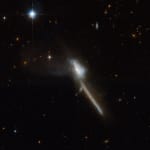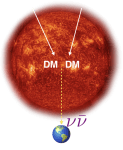Every six minutes, a neutrino flies through the Antarctic ice sheet, and close to an IceCube sensor—also called a DOM—it interacts with a molecule of ice and creates a tiny amount of light that triggers data-taking for an event in the IceCube neutrino detector. If this is a high-energy event, a beautiful track or a […]
Research
Confirmation of whether galactic X-ray binaries emit high-energy neutrinos awaits IceCube-Gen2
X-ray binaries (XRB) consist of a compact object, such as a neutron star or a black hole, and a noncompact, companion star. When they are close enough, material is pulled off the star and drawn onto the compact companion, releasing intense X-rays that make them some of the most luminous sources in the sky. Microquasars, […]
New IceTop measurements shed light on the cosmic-ray muon puzzle
It took a solar eclipse and a balloon flying up to 5,300 meters to point to outer space as the origin of the ionizing radiation in the atmosphere. The discovery of cosmic rays was made by Victor Hess in 1912 and earned him the Nobel prize in 1936. Since then, scientists around the world use […]
IceCube unveils the world’s most precise search for mysterious new neutrino interactions
Neutrinos have mass. Their mass is small, extremely small in fact, but contrary to what the Standard Model of particle physics predicts, they do have mass. A consequence of this nonstandard property is that neutrinos oscillate, which means that as they speed through matter or space, their flavor—or type—changes at a rate that depends on […]
IceCube and the mystery of the missing magnetic monopoles
We are all surrounded by magnets. Whether they’re on your fridge, in your smartphone, or in your credit card, the magnets you interact with all have one thing in common (well, two things): they each have a north and south pole. Could a magnet ever have just one pole? Yes, according to scientists, and it’s […]
Improvements to deciphering the cosmic muon neutrino flux
Neutrino astronomy had a pivotal moment in 2013 when the IceCube Collaboration announced that their South Pole neutrino telescope had detected the first evidence of an astrophysical neutrino flux. This was confirmed in 2015 with an independent search in the Northern Hemisphere, also by IceCube. Since then, IceCube and other experiments have learned more about […]
IceCube explores active galactic nuclei as sources of the astrophysical neutrino flux
In 2013, the IceCube Neutrino Observatory detected very high energy particles called neutrinos that arrived at Earth from outer space. Not only did IceCube confirm the existence of astrophysical neutrinos, but they also proved that these elusive particles could be detected by their cubic-kilometer-sized telescope buried in the South Pole ice. Even though IceCube had […]
Brightest infrared objects are likely not responsible for the astrophysical neutrino flux
By Madeleine O’Keefe and Pablo Correa In the constellation Ursa Major, there is a galaxy with the uncanny appearance of a particular dental hygiene tool. Aptly nicknamed the “Toothbrush” galaxy, Mrk 273 is actually a merger of two galaxies and an example of an ultraluminous infrared galaxy (ULIRG). It might be a source of astrophysical […]
IceCube places the strictest constraints on WIMPs from the sun
Many people think of our sun as being bright. It is an enormous ball of glowing gas that illuminates our days and provides Earth with heat and light. But it is also being explored for signals of something darker: dark matter. Dark matter is not literally dark; it is invisible because it does not interact […]
IceCube conducts a search for multiple flaring episodes from neutrino sources with 10 years of data
The IceCube Neutrino Observatory, a peculiar telescope located in the ice of the South Pole, was built to detect mysterious particles called neutrinos that come from outer space. To pinpoint their cosmic sources, IceCube researchers look for unexpected excesses of neutrinos coming from localized directions in the sky. In a paper published in 2020, IceCube […]









